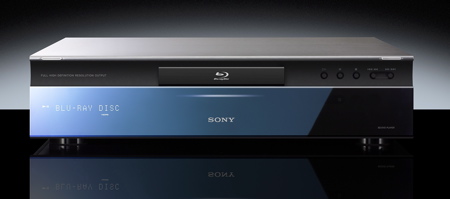Sony Steps Into 2006

At a Blu-ray panel that preceded the product tour, representatives of various Sony divisions—marketing, home products, media applications, storage media, and VAIO computers—had their say and fielded questions from the press.
By the end of the year worldwide production capacity for Blu-ray movie discs (BD-ROMs) should reach 10 million. The movie discs are expected to include both Dolby Digital and DTS audio, and can optionally carry the new high-resolution multichannel audio formats announced by both Dolby and DTS. But there are no plans to put these new formats on any of the first Sony Blu-ray releases.
The linear, uncompressed PCM multichannel tracks Sony does plan to put on their Blu-ray titles will be available from 5.1-channel analog outputs. Sony's press materials also suggested that these tracks will also be carried from player to receiver in digital form on HDMI. We'll reserve judgment on the latter until we see the discs and players. A recent listen to two-channel stereo via HDMI did not impress me; it sounded noticeably inferior to a standard coaxial digital connection.
Sony's player will also output video at 1080p/24, 1080p/60, or 1080i/30, as selected by the user. It will also play back DVDs, upconverted to 1920x1080. But there's no guarantee that players from other manufacturers will offer all these audio and video options; check the features on any player before you buy. That goes for HD DVD as well. These are new formats, and until we see the actual players we aren't assuming anything, and neither should you.
The first Blu-ray discs will be single layer; expect dual layer releases by summer. (There's also a 100GB, four-layer version expected by 2007, but that format is likely to be used only for computer data storage. Sony estimates the archiving life of recordable BD media at 30 years.)
So far five studios supporting Blu-ray—Sony, MGM (the MGM library is owned by Sony), Fox, Disney, and Paramount—have agreed, at least for now, not to implement the ICT flag (Image Constraint Token is a flag in the software that instructs the player to downconvert the analog component output to a maximum resolution of 960x540). So those with older displays sporting only component inputs should see full high-definition on releases from these studios. The only major studio that has yet to commit to this non-ICT policy is Warner Brothers.
On the computer side, Blu-ray drives, as well as desktop computers containing these drives, should appear in Sony's VAIO line by summer. Sony will also market single and dual layer BD-R and BD-RW discs, ranging in price from $20 for single layer recordable BD-R to $60 for dual layer rewritable. A bit further down the road we'll also see a BD drive in one or more Sony VAIO laptops. (If you haven't already guessed, BD is becoming a widespread alternative designation for Blu-ray discs, thus we have BDP-S1, BD-ROM, BD-R, and BD-RW.)
The only immediate application that was suggested for these media was for storage of material shot on HD consumer camcorders; Sony now markets such camcorders for under $2000. But standalone Blu-ray recorders for the U.S. market are still well out of radar range. One application we all want is the ability to record open-source HD programming (received via antenna, cable, satellite, or temporarily stored on a DVR) onto an optical disc (Blu-ray or HD DVD) in full HD resolution for long-term storage. But that capability is still vaporware. It will come, if the content providers don't insist on preventing it with the powerful copy prevention tools now at their disposal.
Meanwhile, back in the product demonstration area, we were shown a split-screen image comparing HD on Blu-ray vs. the same material on DVD. The display was one of the current Sony 60" SXRD rear projection sets. It was clear that you won't need a huge front projection screen to see the benefits of high definition programming on Blu-ray.
There was nothing new from Sony in either SXRD rear or front projection. Sony promises new SXRD rear projection sets (up to 70" diagonal) in the fall. Some of these will accept 1080p directly at their HDMI inputs (the current sets will not). These sets may also be much shallower than the already slim current models, if the prototype we saw of the new 55" design was any indication.
Sony did show three new Grand WEGA 3LCD 720p rear projection sets: the 46-inch KDF-46E2000 at $2,200, the 50-inch KDF-50E2000 for $2,500, and the 55-inch KDF-55E2000 for $3000. They all offer Cinema Black Pro, which includes an Advanced (dynamic) Iris for better blacks.
Two new lines of Bravia LCD flat panel displays join the current Bravia XBR sets. The Bravia S series, now shipping, offers five sizes ranging from 23" to 46" (diagonal), and topping out in price at $3999 for the 46" model. The Bravia U series, expected this summer in similar sizes, will be HD-ready only—that is, the U-series sets will require an outboard tuner, cable box, or satellite decoder.
Sony also had their Qualia 005 on display. That's the 46" diagonal, 1920 x 1080, flat panel LCD with LED backlighting that's been a crowd-gathering highlight at Sony shows for over a year now. While it produced a gorgeous picture, this $15,000 product is more than anything a technology demonstration—a taste of things that we may see in more affordable products within the next year or two. Yes, according to Sony the Qualia 005 will be offered for sale in the U.S. But don't expect to find it on the showroom floor at your neighborhood Best Buy anytime soon!

























































